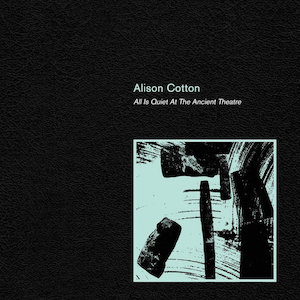 Alison Cotton – All Is Quiet At The Ancient Theatre
Alison Cotton – All Is Quiet At The Ancient Theatre
Cardinal Fuzz/Feeding Tube Records – 16 November 2018
Avid and regular readers of this site will need no introduction to Alison Cotton. She’s one half of songwriting partnership The Left Outsides (with Mark Nicholas), also a member of psych-folk band Trimdon Grange Explosion and an occasional contributor to the United Bible Studies collective. The arguably more avant-garde demeanour of her recent collaborative cassette with Plinth’s Michael Tanner (on Reckno and Dark Companion) sort-of points the way to All Is Quiet At The Ancient Theatre, which turns out to be Alison’s debut solo release. It was actually released four months ago, in July this year (by Bloxham Tapes), on limited-run cassette; thankfully, now it’s time for its appearance on more robust formats – ie. vinyl, vinyl-replica CDR and digital.
All Is Quiet…consists of just five improvised tracks, the shortest of which clocks in at a little over five minutes. On the opening ten-minute title piece, the eerie, tangibly dark atmosphere of the music arises initially out of a simple repeated viola phrase, a long-breathed line whose haunting drone comes to provide a shape-shifting bedrock – onto, over and through which float at first subliminal (later more stratospheric) vocal parts and additional fragmentary contributions from harmonium, recorder, drum and chimes. It all builds naturally and gently inexorably, and the effect is truly mesmeric, and it’s very easy to become immersed in the beautiful, if slightly austere textures, once you grow accustomed to Alison’s modus operandi and the underlying pulse of her music. I also sense a certain kinship with the wiry, more minimal adventures of Laura Cannell (of Horses Brawl) here.
The album’s second piece, The Last Sense To Leave Us, is perhaps more cryptic, building from parallel layering of viola and vocal lines, although the more expansive, spacious nature of its invention may recall the spiritual ambience of the music of the late John Tavener as much as some of the John Cale/Nico experiments. The album’s central piece 36 Dramatic Situations was originally written and performed as a soundtrack to the film of that name by Jessye Curtis and involves the use of tape delay; the piece also feels somehow more depictive (if not strictly programmatic), notably in its deployment of specific techniques and effects from the armoury of the classical string player (such as tremolo and double-stopping).
The Bells Of St. Agnes might perhaps be considered the most immediately striking (in the sense of “eventful”) piece on the album, not least since it’s the disc’s closest approximation to song form. It begins in multitracked a cappella vocal mode with plainchant-style gestures before actual lyrics are sung over a throbbing mid-register string drone punctuated by muffled drumbeats and transitory melodic fragments; there’s even a further glimpse of daylight with the introduction of a recorder into the viola-rich texture during the last half-minute of the track’s length. After a vocal prelude, the final track, A Tragedy In The Tithe Barn, gives prominence to a viola melody whose folksome richness may recall Vaughan Williams’ Flos Campi and continues to intrigue before the drumbeats return ominously and intermittently and the track draws to a (premature) close.
A sometimes distinctly mournful, often attractively melancholic aura of antiquary ritual pervades Alison’s music. It follows, therefore, that this disc is well named, for its sense of stillness and ancientry is both powerful and all-embracing – helped greatly by the mystical reverberance/s of the recording – and the listener is inspired and encouraged into a state of close attentiveness, for this is eternal, irresistible and stimulating music that provides ever-increasing reward on successive replay.
Available via Bandcamp | Cardinal Fuzz | Feeding Tube Records

